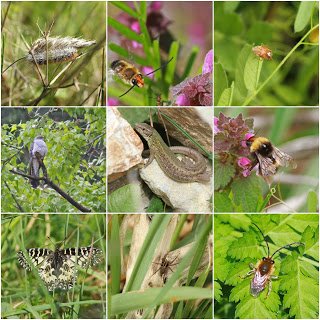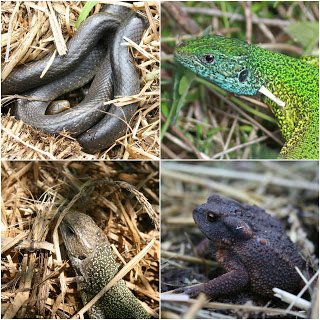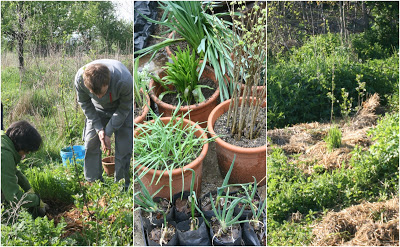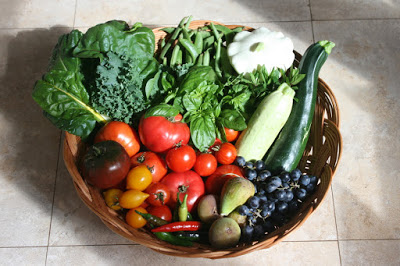Here's an update of what we've been up to during the Market Garden Polyculture study.
The full team is now here and what a great group of people to work with! We're looking forward to productive seasons.
The Brilliant 2016 Polyculture Market Garden Study Team - (left to right) Marika - Ute - Alex - Charlotte - Kata
Biodiversity Study
The last 3 years we have been gathering data to show the productivity of our models (see here) but currently lack a measure of biodiversity to support the casual observation of enhanced levels within the gardens. This year we are beginning to explore this with three entomological surveys headed up by my brother Peter Alfrey. Here's a post on how the first study went.

Photos from our first biodiversity survey - Photos by Ute Villavicencio and Peter Alfrey

Bio-blitzing one of our new plots that we'll be planting out as part of the upcoming Perennial Polyculture study.
Garden Bed Preparation
We've been busy getting the beds prepared for over 2,500 plants going in over the next few weeks. Some will be transplanted from seedling trays and cloches others will be sown directly.
The Market Garden, Westerly view
Here's a breakdown of what bed preparation entails.
Weeding - Following the last harvest in November, the beds are left undisturbed until the spring just before we apply compost and mulch. The native plants that have established on the beds during this period are cut to ground level or pulled and placed on the surface. Plants growing around the edges of the bed are mown to ground level. Only plants with rhizomatous growth (tissue that can re sprout from small pieces) should be removed from the beds e.g mints Mentha spp. and Couch grass - Elymus repens
Beds with perimeter vegetation mown and weeds chopped and dropped
Forking over - Going over the bed with a fork helps to relieve compaction, aerates the soil and provides a more favourable environment for the roots of the new crops to grow in. The soil is not turned only fractured. This can be done before weeding if you want to pull up deep rooted weeds.
Adding Ash - 100-120 g of ash (that's approx a hand trowel full) is sprinkled evenly over each meter length of bed. The ash helps to moderate pH and provides a range of essential plant nutrients. For more on using ash in the garden see here.
Adding Compost - 20 L of compost per m length is applied evenly to surface of the beds.
We're using composted farmyard manure in the garden.
Mulching - Straw is applied to the surface of the beds at a rate of 1 bale every 1.5 m of bed length. It's best to wait until the soil has warmed and rain has saturated the soil before applying the mulch.
We collect spoiled straw from local farmers. The bales being wet are of no use to the farmers for animal bedding and we collect them free of charge. Wet bales can sometimes harbour slugs, in which case it's not a great idea to use them for mulch in the vegetable garden. Setting chickens onto infested bales will soon clear the slugs.
Straw bale stacks at least 2 bales high provide excellent habitat for a range of organisms and we leave a bale stack around often finding Aesculapian snake - Zamenis longissimus and Slow Worms - Anguis fragilis sheltering in the bales. Toads - Bufo bufo also use the bales for overwintering and summer shelter as do Balkan Lizard - Lacerta spp.

Common inhabitants of the straw bale stacks.
Soil Health Tests
As well as the lab analysis of our soils at the beginning of each season we also take visual tests using a soil health test developed by farmers for farmers to track the development of soil health. More on soil testing and the results from the tests here.

8 tests looking at water infiltration, ground cover, soil organisms, soil structure and more are tested using simple equipment.
Work in the Forest Garden
Tree Pit Planting
We spent sometime in the forest garden tending to the newly planted fruit trees, weeding and adding a fresh layer of mulch. We also planted some support plants around the base of the young trees. Listed below are the species planted and their functions.

Tree pit planting in the forest garden
Caragana arborescens - Nitrogen fixing shrub that will be cut annually to provide biomass both from the roots and shoots of the plant.
Allium tuberosum or Allium cepa proliferum - Perennial vegetables for the market garden that also attract beneficial pest predators and pollinators.
Narcissus poeticus - Early pollenizers attracting bees and other pollinating insects to the garden and providing a nutrient capture when little else is growing during the cold months.
Corydalis spp. - Early pollenizers attracting bees and other pollinating insects to the garden and providing a nutrient capture when little else is growing during the cold months.
Galanthus spp. - Early pollenizers attracting bees and other pollinating insects to the garden and providing a nutrient capture when little else is growing during the cold months.
We'll eventually place boulders around the edges of the tree pits which provide excellent habitat for a range of beneficial organisms. See here for more on rock borders.
Other work in the forest garden included mowing some access paths, the trimmings of which are fed to the comfrey patch, and cutting back vegetation from the edible hedgerow that overhangs the pathways.
Pathways are cut into the vegetation using a 50 cm wide lawnmower. This directs foot traffic through the garden and reduces the likelihood of treading on snakes that are active this time of year
Sending Produce to Market
Last week we again began offering garden produce to the Sofia based food coop Trustika.

Produce available this time of year includes fresh garlic, perennial onions, herbs, perennial salad greens and potted herbs & perennial vegetables from our bio-nursery. We're growing a wider variety of crops this year, such as parsnips, beetroot, aubergine and carrots, and are trying out several tasty and unusual varieties of old favourites, such as kale, chard, courgettes, tomatoes and beans.
You can try some of these delicious goodies and directly support the Polyculture Market Garden Study by signing up for our Vegetable Box Scheme (BG language here, ENG language here). We offer three different sized boxes for singles, couples or families and include seasonal fruits in the boxes if desired.

Nice post I like what yours dooing :)
Downvoting a post can decrease pending rewards and make it less visible. Common reasons:
Submit